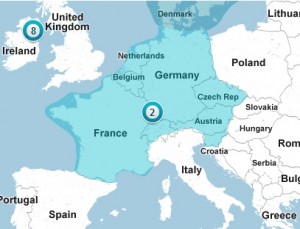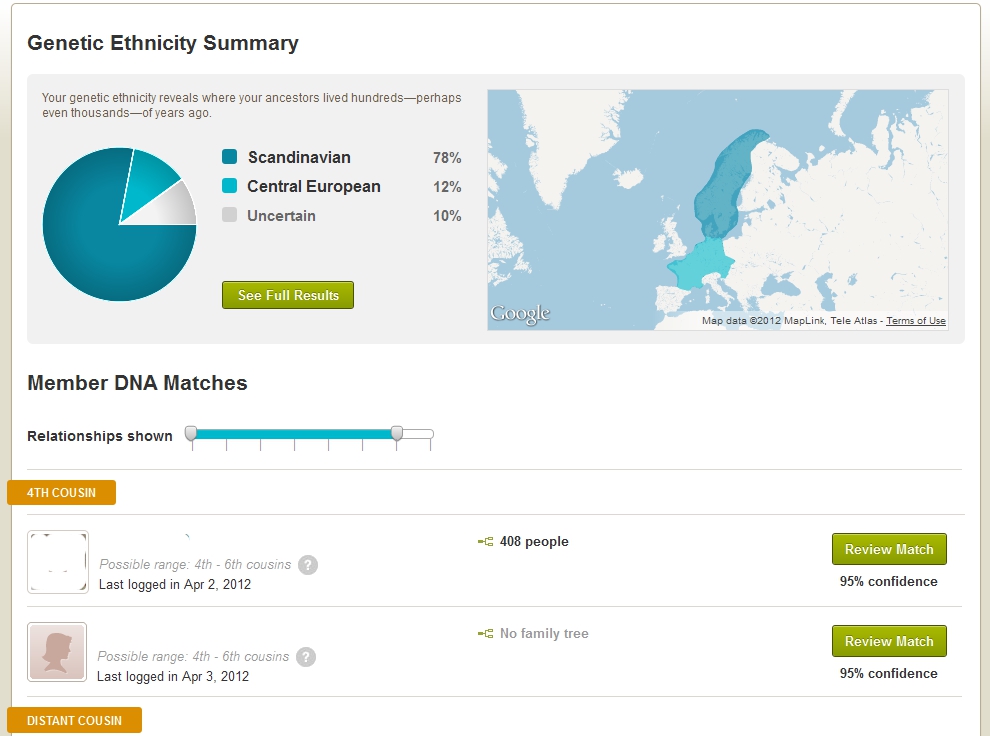Im Going to Need a Detailed Estimate From You Then Youll Never Hear From Me Again

I've received a number of emails and comments (meet, e.1000., here) complaining near Ancestry.com's new exam, AncestryDNA. Specifically, several test-takers believe that the Genetic Ethnicity Prediction provided by Ancestry.com does not reflect the numbers that they expected based on their own research.
For example:
"I simply got my DNA test results dorsum from Ancestry.com and I am concerned. I was born in England and I have gone dorsum many generations and have institute that all my ancestors every bit far back as the 1600′s in most cases are English. According to the results I have no British Isles DNA. It states that I have sixty% Central Europe, 30% Scandinavian and 7% Southern Europe. I also take 3% unknown. How tin this be?"
"Merely received my results: 21% Southern European and 79% Primal European which doesn't follow years of work on my family history."
Do these comments reverberate errors in AncestryDNA's Genetic Ethnicity Prediction, or are there other factors at play?
Caveats
Although I am non privy to the 'behind-the-scenes' at Ancestry.com, I don't believe that there are serious bug with AncestryDNA'south Genetic Ethnicity Prediction. Ancestry.com's DNA arm has a solid scientific team and a large and valuable reference database.
Indeed, Ancestry.com is well enlightened of the limitations and challenges that their Genetic Ethnicity Prediction brings:
We apply cut-edge science as a base for our predictions, only that comes with its ain inherent challenges. Information technology's an emerging field with exciting new discoveries and developments constantly changing the mural. Correct now, your genetic ethnicity may not await quite right, with some ethnicities under or over-represented. As scientists gain a deeper understanding of the data, our prediction models volition evolve to provide you with more than accurate and relevant information about your family history.
It's important to understand that biogeographical estimates, which are even so relatively new, are notoriously difficult and complicated. Ten different researchers analyzing the same genome tin can come up with 10 unlike estimates based on a number of different factors, including their algorithm, the reference populations used for comparison, and many others.
Here are just a few factors that can influence a biogeographical approximate, and any one or more than of these may be the reason that your Genetic Ethnicity Prediction does not friction match estimates you make based on your paper trail.
- Different Reference Populations and Algorithms
As I suggested higher up, unlike companies utilize unlike reference populations and algorithms to create a biogeographical judge, which tin result in varying estimates.
For example, in my previous review of AncestryDNA'southward Genetic Ethnicity Prediction, I compared my genetic ethnicity results from three companies (Ancestry.com, 23andMe, and FTDNA), and found that their results varied considerably. I'm not surprised by this, but I practise expect that over time – every bit the industry arrives at more standard reference populations and algorithms (which the cheap whole-genome sequencing revolution volition enable) – that estimates from different companies will align much more than closely. Exist patient and savour existence a pioneer.
- You Take Ii Family Trees!
Recollect that "Anybody Has 2 Family Trees – A Genealogical Tree and a Genetic Tree." Your Genealogical Tree is the tree containing ALL of your ancestors. However, merely a tiny subset of these individuals actually (randomly) contributed DNA to the genome that you walk effectually with today. These ancestors are the only individuals in your Genetic Tree. It has been estimated, for example, that at 10 generations, only almost 10-12% of ancestors in your Genealogical Tree are actually in your Genetic Tree!
Accordingly, even if a decent percentage of your ancestors at 10 generations originated in the British Isles, there is possibility that your DNA – and thus your Genetic Ethnicity Prediction – could include very piffling or admittedly no British Isles ancestry, simply considering of the rules of genetics.
Ancestry.com tries to explain this equally well (I'm biased, simply I think my "Everyone Has Two Trees" explanation is a little clearer; I've had slap-up luck explaining this to newbies):
And so if you look at your family tree, it may bespeak a pedigree-based ethnicity of xxx% English, 20% Scandinavian, and 50% Italian (based on birth locations of your great-nifty-great grandparents). While this is ane valid style to await at ethnicity (and in fact has been the only manner until recently), Dna analysis can reveal the actual percentage of your Dna that is reflected by these ethnic groups. So your genetic-based ethnicity might reveal yous are 40% British Isles, 15% Scandinavian, and 45% Southern European. Both measures are accurate and informative—but they are measuring unlike things.
- Misleading Labels
Another upshot with any biogeographical estimate is the labels used to describe a population. For case, what does "Scandinavian" or "Central European" actually hateful? Does "Scandinavian" mean that great-grandpa must have been a Swede, or does it hateful something else?
Ancestry.com defines the "Scandinavian" with the modern 24-hour interval locations of Kingdom of norway, Sweden, Denmark, but explains in their FAQ that it can mean much, much more:
Ethnic groups moved effectually. Because people move over time, (and when they do they have their Deoxyribonucleic acid with them), a group may contribute Dna to other groups at different times. So indigenous groups can be defined past time and place—not only location. For example, if you have German or British ancestors in your family tree, information technology'due south a possibility that your genetic ethnicity may be partly Scandinavian. The Viking invasions and conquests most a thousand years ago are likely responsible for occurrences of Scandinavian ethnicity throughout other regions. And there are like examples for other ethnicities. With your results, we provide historical information describing migrations to and from the regions to give you a broader flick of the origins of your DNA.
 Similarly, the "Key European" label is defined to include the enormous swath of country in Europe including the mod solar day locations of Austria, Belgium, France, Germany, Netherlands, Switzerland, Slovenia, Czech republic, Luxembourg, and Liechtenstein.
Similarly, the "Key European" label is defined to include the enormous swath of country in Europe including the mod solar day locations of Austria, Belgium, France, Germany, Netherlands, Switzerland, Slovenia, Czech republic, Luxembourg, and Liechtenstein.
I certainly don't think of France equally being "Primal Europe," which shows that a examination-taker shouldn't rely on the labels lone. Dig a little deeper.
- Non-Paternal Events (NPEs)
I won't dwell on non-paternal events, because I believe they have become too much of a scapegoat. Non-paternal events, or NPEs, can be broadly defined as secret or unknown breaks in your Genealogical Tree (adoption, infidelity, etc.). At some point every single Genealogical Tree has an NPE, although current estimates vary widely. Consider the possibility of a break in your tree, simply focus on the other factors presented here equally the more likely explanation for your unexpected results.
Reviewing My Genetic Ethnicity Prediction
I have a fairly well-documented Genealogical Tree. My documented ancestors were generally from the British Isles (England and Ireland) and France, with far fewer ancestors from Federal republic of germany, and Central America. Years ago, based on my paper trail, I might have predicted 65% British Isles, 20% Irish, 15% French, and five% German language.
In light of the to a higher place, let'south review my AncestryDNA Genetic Ethnicity Prediction:
- Scandinavian – 78%
- Central European – 12%
- Uncertain – 10%

At first glance and without any of the knowledge above, these numbers seem way out of whack. I don't accept a single document ancestor from Scandinavia or the area I think of every bit "Key Europe."
However, when I larn that "Central Europe" includes France and Germany, a contribution of 12% "Central European" doesn't seem far-fetched. Farther, considering that ancestry in the British Isles can include "Scandinavian" ancestors every bit a outcome of relatively recent Viking conquests (on a genetic timescale), perhaps the 78% Scandinavian isn't so far-fetched either.
While I am even so surprised that I don't study whatsoever British Isles Deoxyribonucleic acid, that could simply be because of difficulties in deciphering betwixt Scandinavian and British Isles, or mayhap because of the random inheritance of Deoxyribonucleic acid from those ancestors rather than others.
Lastly, where's my confirmed Native American and African Dna? Well, these percentages are rather small (~ or <5% each) and I'm certain they're contained within the "Uncertain" category.
In any issue, I'yard not discouraged by my results, and I fully expect my results to change over fourth dimension.
Conclusions
Lastly, every bit Ancestry.com has warned, don't forget that your results are subject to change with revisions of their algorithms and new discoveries. And if Ancestry.com is defended to the best and latest results, your results most certainly will and should change.
Your Turn
What are your percentages? Do they match your expected percentages? If you were unhappy with your AncestryDNA Genetic Ethnicity Prediction, does any of the above alter your view?
This website uses cookies to meliorate your experience. Click to Accept or Opt Out. AcceptReject Read More
Source: https://thegeneticgenealogist.com/2012/06/19/problems-with-ancestrydnas-genetic-ethnicity-prediction/
0 Response to "Im Going to Need a Detailed Estimate From You Then Youll Never Hear From Me Again"
Post a Comment